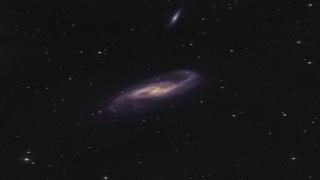Bibcode
Seibert, Mark; Sheth, Kartik; Salo, Heikki; Regan, Michael W.; Muñoz-Mateos, Juan-Carlos; Menéndez-Delmestre, Karín.; Mizusawa, Trisha; Laurikainen, Eija; Laine, Jarkko; Kim, Taehyun; Holwerda, Benne W.; Ho, Luis C.; Hinz, Joannah L.; Gadotti, Dimitri A.; Gil de Paz, Armando; Erroz-Ferrer, S.; Elmegreen, Bruce G.; Comerón, Sébastien; Bosma, Albert; Athanassoula, E.; Knapen, J. H.; Trujillo, I.; Bakos, J.; Martín-Navarro, I.
Referencia bibliográfica
Monthly Notices of the Royal Astronomical Society, Volume 427, Issue 2, pp. 1102-1134.
Fecha de publicación:
12
2012
Número de citas
66
Número de citas referidas
60
Descripción
The mechanism causing breaks in the radial surface-brightness
distribution of spiral galaxies is not yet well known. Despite
theoretical efforts, there is not a unique explanation for these
features and the observational results are not conclusive. In an attempt
to address this problem, we have selected a sample of 34 highly inclined
spiral galaxies present in both the Sloan Digital Sky Survey (SDSS) and
the Spitzer Survey of Stellar Structure in Galaxies (S4G). We
have measured the surface-brightness profiles in the five Sloan optical
bands and in the 3.6-μm Spitzer band. We have also calculated the
colour and stellar surface mass density profiles using the available
photometric information, finding two differentiated features: an
innermost break radius at distances of ˜8 ± 1 kpc [0.77
± 0.06 R25] and a second characteristic radius, or
truncation radius, close to the outermost optical extent (˜14
± 2 kpc [1.09 ± 0.05 R25]) of the galaxy. We
propose in this work that breaks might be phenomena related to a
threshold in the star formation, while truncations are more likely a
real drop in the stellar mass density of the disc associated with the
maximum angular momentum of the stars.
Proyectos relacionados

Huellas de la Formación de las Galaxias: Poblaciones estelares, Dinámica y Morfología
Bienvenida a la página web del g rupo de investigación Traces of Galaxy Formation. Somos un grupo de investigación amplio, diverso y muy activo cuyo objetivo principal es entender la formación de galaxias en el Universo de una manera lo más completa posible. Con el estudio detellado de las poblaciones estelares como bandera, estamos constantemente
Anna
Ferré Mateu

Las Galaxias Espirales: Evolución y Consecuencias
Nuestro grupo pequeño esta bien conocido y respetado internacionalmente por nuestro trabajo inovativo e importante en varios aspectos de la estructura y la evolución de las galaxias espirales cercanas. Usamos principalmente observaciones en varias longitudes de onda, explotando las sinergías que nos permiten responder a las cuestiones más
Johan Hendrik
Knapen Koelstra